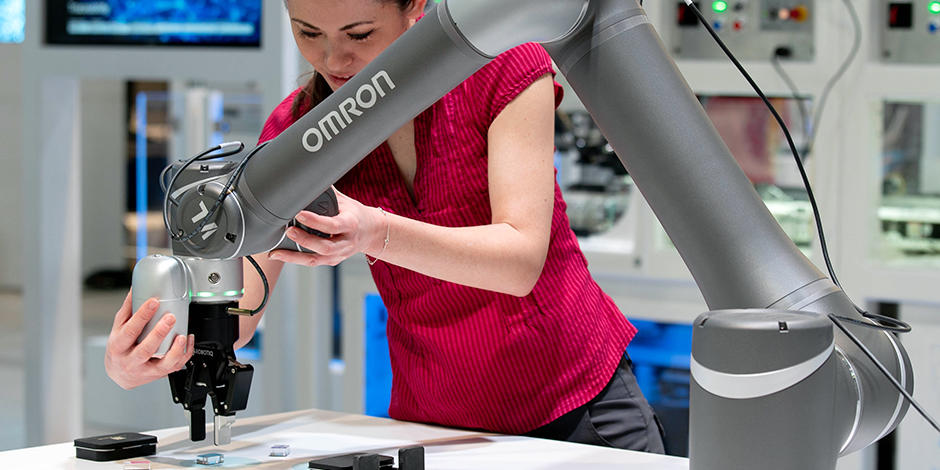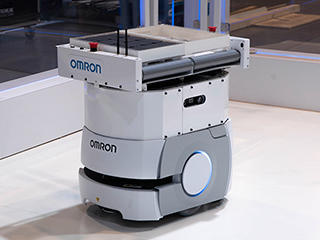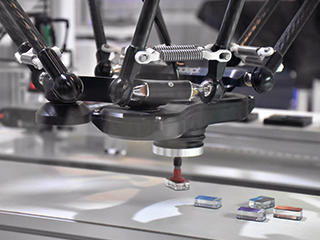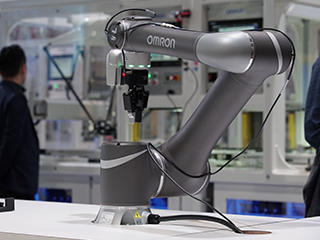
![]()
A pioneer in factory automation, OMRON has developed many automation solutions for a diverse range of usage situations. These various solutions were on display at CES2019. OMRON's booth was divided into two main areas: one area featuring FORPHEUS, OMRON's robot table tennis tutor, and Factory Harmony, representing the near-future of factory automation. In a way, FORPHEUS is the "theory", and Factory Harmony the "application": all the different technologies in FORPHEUS are each optimized and adapted for automation purposes in Factory Harmony.
In the Factory Harmony area, attendees could observe the production of personalized magnets. The production line is a collection of different OMRON machines each exemplifying OMRON's core technology, Sensing & Control + Think. Attendees could experience not only the state-of-the-art mass customization process, but also receive souvenir boxes containing magnets in their preferred colors, freshly printed with their names.
There are several steps involved in producing laser-printed personalized magnets. Firstly, one needs to know the name and preferred color of the attendee. OMRON staff scans the attendee's badge, and the code will give the identity of the badge holder. The choice of colors is also given on the panel, where attendees can choose from a range of colors. This information is quickly passed down to the laser printing unit, which selects the correct colored magnets from the batch, and prints the name on each of them. If humans were to perform this, the communication of relevant data would already have taken a minute or two. However, with robots, this process can be completed in less than half a minute.
The customized magnet now needs to be packaged. The magnets are picked up from the conveyor to boxes. This cannot be just any box-- they need to be the matching box with the attendee's name printed on it. In addition, the slots in the boxes are in the shape of the magnets, requiring precise configuration so that magnets can sit in the slots. Otherwise, they could fall out, or cause the lid to not close properly.
Finally, the box is delivered to the hands of the corresponding attendee, waiting outside.
As you may have seen, the simple task of producing laser-printed personalized magnets is in fact very complex. They require a combination of different sensors, motor capacities and controlling mechanisms. Some of the machines that worked together to allow this to happen were the mobile robots, laser marker, pick & place robots and collaborative robots. Each has its strengths and characteristics that support the creation of "harmony between humans and machines".
Here is a brief introduction to these machines:
mobile robots OMRON's mobile robots are self-navigating Autonomous Intelligent Vehicles. It is equipped with a tray which can carry loads of nearly 300 lbs. In the Factory Harmony Area, they transported the magnets and boxes to and from the production line. With the self-navigation software, it can safely move, avoiding obstacles and people. Development is underway to have robots integrated with the mobile robots for autonomous repositioning.
OMRON's mobile robots are self-navigating Autonomous Intelligent Vehicles. It is equipped with a tray which can carry loads of nearly 300 lbs. In the Factory Harmony Area, they transported the magnets and boxes to and from the production line. With the self-navigation software, it can safely move, avoiding obstacles and people. Development is underway to have robots integrated with the mobile robots for autonomous repositioning.
laser marker Laser marking is indispensable in nearly every major market sector for quality control and identification purposes. OMRON's laser marker achieves high-speed, high-accuracy processing improving efficiency of this task. By recognizing the edges of objects, it can print information exactly the same way every time within the designated space. It also self-monitors the tools that it uses, so that they can be sharpened or maintained after a given length of usage time. This laser marker can mark a wide range of surfaces including stainless steel and other metals, plastics and more. In addition, it can also detect shapes even when objects have limited flat surfaces.
Laser marking is indispensable in nearly every major market sector for quality control and identification purposes. OMRON's laser marker achieves high-speed, high-accuracy processing improving efficiency of this task. By recognizing the edges of objects, it can print information exactly the same way every time within the designated space. It also self-monitors the tools that it uses, so that they can be sharpened or maintained after a given length of usage time. This laser marker can mark a wide range of surfaces including stainless steel and other metals, plastics and more. In addition, it can also detect shapes even when objects have limited flat surfaces.
pick & place robots The pick & place robots recognize objects, picks them up and places them down in the desired configuration. In Factory Harmony, they picked the magnets with the correct colors chosen by the attendees and placed them onto the belt conveyor in groups of three. In addition to its high precision and speed, as they have built-in AI, they are able to increase accuracy when humans suggest improvements.
The pick & place robots recognize objects, picks them up and places them down in the desired configuration. In Factory Harmony, they picked the magnets with the correct colors chosen by the attendees and placed them onto the belt conveyor in groups of three. In addition to its high precision and speed, as they have built-in AI, they are able to increase accuracy when humans suggest improvements.
collaborative robots In addition to observing the production line, attendees could also experience the manipulation of robots. Attendees who were interested were invited to program this collaborative robot to package magnets. The collaborative robots can be programed simply by guiding its movements, step by step. Once it has learned the moves, it can correctly choose, from a number of magnets, the correct magnets. Then, it aligns the magnets to fit the shape of the slots in the box. Lastly, it closes the lid, and hands the box gently to the hands of the attendee.
In addition to observing the production line, attendees could also experience the manipulation of robots. Attendees who were interested were invited to program this collaborative robot to package magnets. The collaborative robots can be programed simply by guiding its movements, step by step. Once it has learned the moves, it can correctly choose, from a number of magnets, the correct magnets. Then, it aligns the magnets to fit the shape of the slots in the box. Lastly, it closes the lid, and hands the box gently to the hands of the attendee.
In addition to being simple to use, the collaborative robots are highly versatile. Its arm is capable of attaching various types of devices allowing it to perform tasks ranging from choosing and packaging and even to drilling.
The Factory Harmony Area demonstrated to its many visitors the possibility of creating harmony between humans and machines. OMRON's idea of harmony is not limited to assuring the safety of users and being precise and effective. It extends to a relationship where one can enrich the other, together making processes easier, safer and faster.